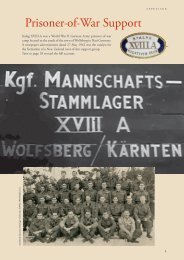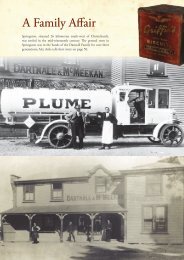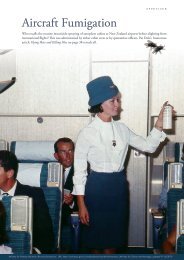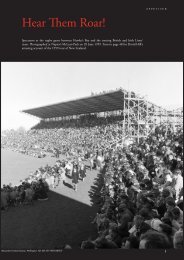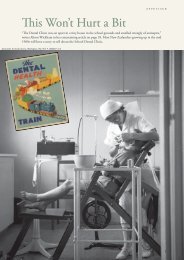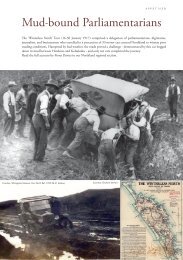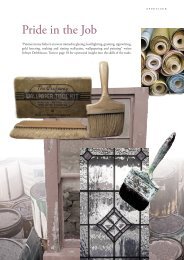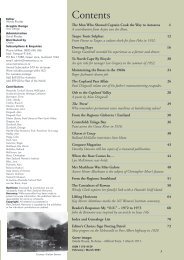New Zealand Memories Issue 151
You also want an ePaper? Increase the reach of your titles
YUMPU automatically turns print PDFs into web optimized ePapers that Google loves.
APPETISER<br />
Egmont Railway<br />
Rail enthusiasts will appreciate the remarkable set of images depicting the building of a branch line up the side<br />
of Taranaki’s mountain; this shows councillors at the water intake site of the crusher station. More outstanding<br />
photographs, contributed by Barrie Smith, appear on page 34.<br />
1
EDITORIAL<br />
Dear Readers,<br />
As with many of our readers, David and I have grandchildren living overseas.<br />
Although the virus has prevented our frequent reunions, the likes of Skype and<br />
inexpensive phone calls enable us to keep in regular contact. It was not always this<br />
easy. I am reminded of my childhood when my parents emigrated from Britain<br />
with two young children; I never saw either of my grandmothers again. With<br />
the high cost of airfares in the late 1950s, and ship voyages taking 5-6 weeks,<br />
there was no real expectation of a return visit. Even to phone ‘Home’, to listen<br />
to a loved-one’s voice on a long-distance booked toll call, was astronomical. No<br />
face-to-face communication then!<br />
The US Marines stationed in <strong>New</strong> <strong>Zealand</strong> during World War II certainly had an impact on <strong>New</strong> <strong>Zealand</strong><br />
society, often with mixed feelings from local citizens. Wartime necessitated family separation: Mark Pacey’s<br />
leading article looks at the Marines located at the Solway showgrounds in Masterton during 1943 for a period<br />
of rest and retraining. Young men far from home.<br />
I am always inspired by the stories of fortitude when we examine <strong>New</strong> <strong>Zealand</strong> history. Gordon Campbell’s<br />
Fiordland road construction account offers a prime example of sheer determination where tools were picks,<br />
shovels and wheelbarrows. Weather conditions brought added hurdles, “Ice picks were needed in the winter<br />
when severe frosts turned the drums of drinking water into solid ice”. We reap the rewards of their labours today.<br />
Readers will appreciate Jilleen Bradley’s charming story, Personal Reflections of Pahi. During a recent visit to<br />
Dargaville, I couldn’t resist the opportunity to take a detour to the sleepy settlement where romance once<br />
blossomed for a young fair-haired schoolteacher.<br />
Special holidays are with us forever, and Beverley Bassett Broad holds fond memories of farming vacations on<br />
Banks Peninsula. The wonderful cover photograph of milking at Onawe Farm immediately transports the reader<br />
back to another era. Bruce Anderson’s camping adventures – and later caravanning – at Auckland’s Piha were<br />
typical beach holidays with little in the way of luxurious trimmings but providing plenty of fun over Christmas.<br />
God bless you until my next editorial, and may our shores continue to remain safe.<br />
Wendy Rhodes,<br />
Editor<br />
For just $79 you receive an annual<br />
subscription to <strong>New</strong> <strong>Zealand</strong> <strong>Memories</strong>.<br />
Six superb issues direct to your letterbox.<br />
A G i f t o f D i s t i n c t i o n<br />
Surprise a friend or relative with a gift subscription.<br />
We will even gift wrap the first issue, include a gift<br />
card with your personal message and post it direct.<br />
Freephone: 0800 696 366 or<br />
Freepost: 91641<br />
PO Box 17288<br />
Green Lane, Auckland 1546<br />
Email: admin@memories.co.nz<br />
Subscribe and Save!<br />
Visit our website w w w.memories.co.nz for subscriptions and gift ideas.<br />
Order online securely today and pay via internet banking or credit card.<br />
2
Editor<br />
Wendy Rhodes<br />
Graphic Design<br />
Icon Design<br />
Administration<br />
David Rhodes<br />
Distributed by<br />
Ovato<br />
Subscriptions & Enquiries<br />
Phone tollfree: 0800 696 366<br />
Mail: Freepost 91641,<br />
PO Box 17288, Green Lane, Auckland 1546<br />
email: admin@memories.co.nz<br />
www.memories.co.nz<br />
Annual Subscription $79 for six issues<br />
(Price includes postage within NZ)<br />
Contributors<br />
Alexander Turnbull Library, Wellington, NZ.<br />
Anderson, Bruce<br />
Barrington, Ernie<br />
Bassett Broad, Beverley<br />
Blundell, E.Doreen<br />
Bradley, Jilleen<br />
Bradshaw, N<br />
Campbell, Gordon<br />
Grant, Jeanette<br />
Harter Family<br />
Hewstone, John<br />
Hickman, Hugh<br />
Hill, David<br />
Hocken Library,<br />
Uare Taoko o Hocken, University of Otago.<br />
Marlborough Historical Society<br />
Mitchell, H<br />
Nelson Provincial Museum,<br />
Pupuri Taonga O Te Tai Ao<br />
Pacey, Mark<br />
Picton Museum<br />
Russell, Tony<br />
Seatter, Tony<br />
Smith, Barrie<br />
Stewart, Graham<br />
Tait, Doreen<br />
Taylor, Mike<br />
Wairarapa Archive<br />
Wickham, Alison<br />
Wickham, Brian<br />
Opinions: Expressed by contributors are not<br />
necessarily those of <strong>New</strong> <strong>Zealand</strong> <strong>Memories</strong>.<br />
Accuracy: While every effort has been made to<br />
present accurate information, the publishers take no<br />
responsibility for errors or omissions.<br />
Copyright: All material as presented in<br />
<strong>New</strong> <strong>Zealand</strong> <strong>Memories</strong> is copyright to the publishers<br />
or the individual contributors as credited.<br />
Contents<br />
The Marines of Solway 4<br />
A contribution from Mark Pacey, Wairarapa Archive.<br />
Personal Reflections of Pahi 10<br />
Jilleen Bradley writes this heart-warming story.<br />
The Ready Reckoner 14<br />
John Hewstone’s original copy of the book is dated 1814.<br />
Farmyard Lost 16<br />
<strong>Memories</strong> of Banks Peninsula from Beverley Bassett Broad.<br />
DIY is in Our DNA 22<br />
No shortage of jobs in a 1904 villa; Jeanette Grant remembers.<br />
From the Regions: Taranaki 26<br />
Centrefold: Delivered in Style 36<br />
Mail delivery by horse drawn carriage near Otorohanga.<br />
Building <strong>New</strong> <strong>Zealand</strong>’s Most Scenic Highway 38<br />
Gordon Campbell explores Fiordland’s road and tunnel history.<br />
Day of the ‘Flivver’ 46<br />
Tony Russell pens an account of the Model T Ford.<br />
<strong>Memories</strong> of Auckland’s West Coast 48<br />
Bruce Anderson recalls childhood holidays.<br />
Canterbury University Activism, 1959 52<br />
Protestor Ernie Barrington’s eyewitness report.<br />
The Finishing Touch 56<br />
Hugh Hickman investigates the once fashionable ‘stick pin’.<br />
From the Regions: Nelson / Marlborough 58<br />
Mailbox 69<br />
Index and Genealogy List 70<br />
Editor’s Choice: Talk Softly Please 72<br />
Ernest Rutherford in the Cavendish Laboratory.<br />
ISSN 1173-4159<br />
August/ September 2021<br />
Cover image:<br />
Eileen Kay milking at Onawe Farm<br />
in the 1950s (article page 16).<br />
Courtesy: Beverley Bassett Broad<br />
3
WORLD WAR II<br />
When the Marines Came<br />
to Masterton<br />
Mark Pacey<br />
The showgrounds in the town of Masterton have been the home of the Agricultural and Pastoral<br />
Association’s annual shows since 1911. Located on the western side of the town, it was originally<br />
comprised of two fields separated by a small section of forest. The larger southern one is the site<br />
of the main show buildings and where the main show activities are held. The northern field has a<br />
railway line running alongside and had been used as holding pens for animals during the agricultural shows. It<br />
was later converted into a golf course which, after falling out of use, was sold for housing.<br />
Queen Street, Masterton in the 1940s.<br />
Courtesy: Wairarapa Archive<br />
4
WORLD WAR II<br />
US Marine Wayne Harter stationed in Masterton.<br />
Courtesy: Harter Family<br />
5
WORLD WAR II<br />
By the end of 2019 the golf greens had gone, the<br />
new roads had been laid and plots had been surveyed<br />
for over fifty new homes. It was common knowledge<br />
that during World War Two the grounds were used as<br />
a camp for both <strong>New</strong> <strong>Zealand</strong> and American soldiers,<br />
but this had begun to fade from memory. In honour<br />
of the site’s military past the developers, Westwood<br />
Property Group, named the new housing site The<br />
Barracks.<br />
In September 1939 the United Kingdom declared war<br />
on Germany. Being part of the British Commonwealth,<br />
<strong>New</strong> <strong>Zealand</strong> followed suit and began to recruit men<br />
to help Britain in her war against Nazi Germany. For<br />
two years young <strong>New</strong> <strong>Zealand</strong> men trained and sailed<br />
for the European war. Meanwhile life continued back<br />
home. Masterton still held its annual Agricultural and<br />
Pastoral shows at the Solway Showgrounds. It wasn’t<br />
until Japan’s entry into the war in December 1941 that<br />
this began to change. With the war much closer to<br />
home, more troops were needed for the Pacific to help<br />
defend against the coming threat. <strong>New</strong> training camps<br />
were set up across <strong>New</strong> <strong>Zealand</strong> to meet the demand<br />
and the showgrounds at Solway were seen as an ideal<br />
site. The 1942 show was cancelled and the Ruahine<br />
Infantry Regiment of the <strong>New</strong> <strong>Zealand</strong> army moved<br />
into the grounds for training and deployment to the<br />
Pacific.<br />
Half a world away, another group of young men<br />
were involved in the same conflict. A month after<br />
<strong>New</strong> <strong>Zealand</strong> declared war on Germany, the Third<br />
Defense Battalion of the United States Marine Corps<br />
was formed. This was in response to the actions of<br />
Germany but also of Japan, whose expansion into the<br />
Pacific was causing alarm.<br />
In April 1940 the battalion boarded a ship and sailed<br />
for Pearl Harbor. They remained there for ten months<br />
and then sailed for Midway Island where they helped<br />
build up the atoll’s defences. By September 1941 the<br />
USMC were back at Pearl Harbor. They were there<br />
on December 7 when the Japanese attacked and were<br />
quick to join in the defence of the base. By the end of<br />
the raid three of the attacking planes had been shot<br />
down.<br />
In May 1942 half the battalion was sent back to<br />
Midway where they helped defend the atoll against<br />
the Japanese attack on June 4. From here it was back<br />
to Pearl Harbor to resupply before they were sent to<br />
their next battleground, the island of Guadalcanal in<br />
the Solomon Islands. The Japanese had been building<br />
an airstrip on the island which would be a threat to<br />
Australia when competed. For six months the Third<br />
Defense Battalion was stationed in the Solomons,<br />
defending against air and sea attacks by the Japanese,<br />
who were determined to recapture the airfield. By<br />
February 1943 the troops were exhausted and sick<br />
with malaria. They were told they would be taking<br />
some time off for rest and retraining, and they would<br />
be doing this in <strong>New</strong> <strong>Zealand</strong>. On February 9 the<br />
battalion boarded the USS George Clymer and sailed<br />
for a safer world. 1<br />
On February 16 the battalion arrived in Wellington.<br />
From here an advance party went by train to the<br />
Solway Showgrounds in Masterton. 2<br />
The advance group was tasked with making<br />
preparations ahead of the arrival of the rest of the<br />
battalion. The <strong>New</strong> <strong>Zealand</strong> Ruahine Regiment had<br />
left a few months before and tents and facilities had to<br />
be put in order in the now vacant camp. In March the<br />
remainder of the battalion arrived at the showgrounds.<br />
Dressed as they were for Guadalcanal, their summer<br />
uniform was inadequate for the much colder <strong>New</strong><br />
<strong>Zealand</strong> climate. One Marine recalled “the first chance<br />
I had I went over the top and shot into Masterton and<br />
picked myself up a nice double eiderdown. I didn’t get<br />
cold from then on.” 3<br />
For the first two weeks in Masterton, the Marines<br />
settled in to their new home. Most stayed in tents, six to<br />
each, which were warmed by stoves supplied by the locals.<br />
Others utilised the showgrounds existing buildings. The<br />
majority camped in the main showgrounds area but<br />
there were several tents pitched on the northern field<br />
which is shown on a wartime plan. Cook houses,<br />
shower blocks and latrines had all been installed prior<br />
to the Americans arriving at camp, although there were<br />
complaints that the hot water in the shower blocks was<br />
lukewarm at best.<br />
After two weeks the troops were still without proper<br />
supplies and began to grow restless. They had brought<br />
some gear with them, which included a souvenir<br />
Japanese bullet casing from Guadalcanal (rediscovered<br />
during excavations), but they were still short of warm<br />
clothes and luxury items. To appease the men, a supply<br />
of 700 bottles of American beer and a large amount of<br />
ice cream was sent up by train. 4 The main food supplies<br />
were provided locally and included meat, vegetables,<br />
fruit and tinned goods which had been brought in<br />
from overseas.<br />
1 Theodore R. Walker, History of the Third Defense Battalion, Fleet<br />
Marine Force U.S. Marine Corps, p. 1-24.<br />
2 3D Defense Battalion, 1265-leb, 1-3.<br />
3 Wairarapa Archive, Oral History 484.<br />
4 Ibid<br />
United States Marine Corps site Solway just after US Marines left. November 1943.<br />
Inset: USMC site looking over bush to northern field. Courtesy: Wairarapa Archive<br />
6
WORLD WAR II<br />
7
MEASUREMENTS<br />
The Ready Reckoner<br />
John Hewstone<br />
About 40 years ago I came across a Ready Reckoner in Wellington dated 1814 (the year before the<br />
Battle of Waterloo). Once outdated it was seemingly given to a small child to practice writing on.<br />
One is left with the unanswerable question, “When did the book arrive in <strong>New</strong> <strong>Zealand</strong> and to<br />
whom did it belong?”<br />
A page in the book is headed Table of Miscellaneous Articles; few people would be able to quote these<br />
measurements nowadays.<br />
Table of Miscellaneous Articles<br />
12 Dozen make a Gross.<br />
A Weight is 256lb.<br />
A Ton of Lead 19½ Cwt.<br />
12 Barrels make a Last.<br />
A Quire of Paper is 24 Sheets.<br />
A Ream of Paper is 20 Quires.<br />
A Bundle of Paper is 2 Reams.<br />
A Bale of Paper is 10 Reams.<br />
A Dicker of Hides is 10 Skins.<br />
A Last of Hides is 20 Dickers.<br />
A Dicker of Gloves is 10 Dozen Pairs.<br />
A Firkin of Butter is 56lb.<br />
A Firkin of Soap is 64lb.<br />
A Tierce of Rice is about 5 Cwt.<br />
A Barrel of Gunpowder is 1 Cwt.<br />
A Last of Gunpowder 24 Barrels<br />
A Pack of Wool is 240lb.<br />
20 Stones of Flour make a Sack<br />
A Load of Timber unhewed is 40 feet.<br />
A Load of Bricks, 500 in number<br />
A Load of Tiles, 1000 in number<br />
A Load of Hay in London is nearly 18 Cwt.<br />
A Chaldron of Coals in London is 36 Bushels<br />
A Chaldron of Coals in <strong>New</strong>castle is 53 Cwt.<br />
A Cart of Coals in Scotland is 12 Cwt.<br />
A Quintel of Fish is 100.<br />
A Barrel of Herrings 500.<br />
Cade of Red Herrings 500.<br />
A Grain of Gold is worth about 2d.<br />
14
MEASUREMENTS<br />
15
36<br />
Mail delivery by horse drawn carriage in the Te Rau-a-moa area, northwest of<br />
Otorohanga. Photographed by William Archer Price in about 1908. The woman in<br />
the forefront holds a mailbag Alexander Turnbull Library, Wellington, NZ Ref: 1/2-001735-G
The 1908 Posties<br />
37
FEATURE<br />
Workers outside the Homer Tunnel in about 1939.<br />
38
FEATURE<br />
Building <strong>New</strong> <strong>Zealand</strong>’s<br />
Most Scenic Highway<br />
Gordon Campbell<br />
The construction of a road through Fiordland’s rugged terrain opened up one of<br />
<strong>New</strong> <strong>Zealand</strong>’s scenic gems to visitors from around the world.<br />
Alexander Turnbull Library, Wellington NZ. Ref; 1/2-009020-F<br />
Have you ever travelled the road to<br />
Milford Sound? Did you give a thought<br />
to the workers who built the road and<br />
the Homer Tunnel? The opening of this<br />
route is the result of hard work and sacrifice, by men<br />
living and working in a geographically and socially<br />
challenging environment.<br />
The majesty and grandeur of Milford Sound has<br />
attracted tourists since the late 1800s. It was initially<br />
accessible only by sea. The discovery of McKinnon<br />
Pass, by explorer Quintin McKinnon, led to the<br />
opening of a walking track. McKinnon marketed the<br />
area and guided parties along the 53 kilometre track,<br />
from the head of Lake Te Anau, to Milford Sound. In<br />
1890, Donald Sutherland, who had lived an almost<br />
hermit-like lifestyle at the head of the Sound, opened<br />
a hotel to accommodate the steady stream of tourists<br />
who walked the track. Milford Sound’s reputation as a<br />
tourist destination grew, and the government quickly<br />
saw the tourism potential of this unique region. In<br />
1901, the Government Tourist Bureau took over the<br />
management of the walking tours along the track, and<br />
established tour boats on the Sound itself. Milford<br />
Sound’s increasing popularity led to pressure for road<br />
access, originally intended to run from Lake Wakatipu<br />
through the Greenstone valley to the Hollyford<br />
valley. The Upper Hollyford valley ends at the Homer<br />
Saddle, named after its discoverer, William Homer.<br />
Homer promoted the idea for a tunnel, large enough<br />
to accommodate a horseback rider, to pass beneath the<br />
saddle and link the Hollyford valley, to the Cleddau<br />
valley, which ran down to Milford Sound.<br />
In the late 1920s it was decided to construct the<br />
road from Te Anau via the Eglinton valley. Work<br />
was organised by the Labour Department as a Public<br />
Works Department project, set up to provide relief<br />
work for the unemployed during the Depression. The<br />
pay was meagre, but as an incentive, the workers on<br />
these PWD relief schemes formed work gangs which<br />
were contracted for sections of work, paid for on a<br />
piecework basis. On good weeks, this system enabled<br />
the workers to earn more than the standard 1/6d (15<br />
cents) per hour that was paid to general labourers at<br />
the time. However, these workers were required to pay<br />
for their own fares to get to and from the work site,<br />
as well as the cost of their electricity, coal and wood<br />
fuel. These, together with canteen and store purchases,<br />
were all deducted from their pay. If wet weather meant<br />
work had to stop, then the men didn’t get paid. The<br />
work consisted mainly of digging spoil out with picks<br />
and shovels and wheelbarrowing it to form the road.<br />
Extra barrows ensured there was no standing around<br />
waiting for a barrow to be filled. It was heavy physical<br />
work, six days a week. As the road progressed up the<br />
Eglinton valley, tall beech trees were cut down with<br />
crosscut saws, the trunks winched aside and stumps<br />
blasted out. The trunks were milled, initially using<br />
saw pits, but later sawmills, and the timber was used<br />
to build bridges.<br />
One of the most challenging sections of the road<br />
was the descent from The Divide, at the head of the<br />
Eglinton valley, to the Hollyford valley below. This<br />
three-kilometre stretch had to be carved into the bluffs<br />
of the steep valley wall. The workers drilled holes into<br />
the rocks with sharp steel spikes and used dynamite<br />
to blast a route. The blast debris was wheeled away in<br />
barrows.<br />
Work camps were set up at intervals along the route.<br />
A large camp, called Marian Camp, was built where<br />
the Lower Hollyford valley meets the Upper Hollyford<br />
valley. The camp consisted of tent huts, a butcher’s<br />
shop, bakehouse, cookhouse, Post Office, first aid<br />
room, workshop and YMCA hut for recreation. This<br />
was the main camp until Homer Camp, which also had<br />
a bathhouse and a school, was built once construction<br />
work began on the tunnel. The workers’ huts were very<br />
39
INDEX and GENEALOGY LIST<br />
A<br />
A & A.J. Caithness 63<br />
A&P Shows 4<br />
Akaroa 16<br />
Albertlanders 10<br />
alcohol 8<br />
All Blacks 51<br />
American Army 51<br />
American food (WWII) 8<br />
Anawhata 51<br />
ANDERSON Bruce 49<br />
Grandmother 51<br />
ANDERSON Harold 40<br />
ANDERSON Johnson 48<br />
Ruth 48<br />
apartheid 52<br />
Arapohue 10<br />
athletics 62<br />
Auckland 48<br />
avalanche (Fiordland) 43<br />
Avro plane 51<br />
B<br />
Banks Peninsula 16<br />
BARRINGTON Ernie 52<br />
Barry's Bay cheese 21<br />
BASSETT Betty 17<br />
Beverley 17<br />
Carol 17<br />
Ken 17<br />
BAXTER Mr G 68<br />
BEVAN Mr V.D. 52<br />
BOLLAND Rev. William 28<br />
BRADLEY Alexander 10<br />
Clare 10<br />
Clarissa 10<br />
Jileen 10<br />
John 10<br />
Mabel 11<br />
Maude 12<br />
Norah 13<br />
Susannah 10<br />
Washington 11<br />
Brothers Islets 66<br />
Brothers Lighthouse 67<br />
Brown's Boarding House 48<br />
building permits 25<br />
BURTON Mr G 68<br />
C<br />
campground (Piha) 48<br />
camping 48<br />
Canterbury University 52<br />
CANTWELL Mr T 68<br />
Cape Koamaru 66<br />
car catalogues 46<br />
caravan (home built) 51<br />
cattle 18<br />
Cavendish Laboratory 72<br />
Christchurch 52<br />
Christchurch City Council 54<br />
Church Hill (Nelson) 60<br />
Citizens All Black Tour Assn. 53<br />
CLARKE Jeanette 22<br />
Reay 22<br />
Cleddau Valley 44<br />
CONZA Mr S 68<br />
Cook Rock 67<br />
Cook Strait 67<br />
cowshed (herring bone) 31<br />
CRAIG Selywn 51<br />
CRAW Graham 51<br />
CRUM Family 49<br />
CURTIS Family 49<br />
D<br />
dairy farmer 30<br />
dances (WWII) 8<br />
DENT Mr and Mrs 51<br />
do-it-yourself 22<br />
Duvauchelle Show 17<br />
E<br />
EGGERS Bill 58<br />
Pat 58<br />
Eglington Valley 39<br />
Egmont crusher station 34<br />
engineering (viaduct) 63<br />
Esson's Valley 63<br />
F<br />
FARLEY Family 48<br />
farming 16, 30<br />
fashion 56<br />
FENTON Family 51<br />
Fiordland 39<br />
FRANCIS Mr C.F. 34<br />
Friesian cows 18<br />
G<br />
gelignite 32, 41<br />
GLASSON Steve 45<br />
Glastonbury Thorn 28<br />
Government Tourist Bureau 39<br />
GOVETT Archdeacon Henry 28<br />
H<br />
HALBERG Murray 62<br />
HAMLEY Joseph 29<br />
HARGREAVES Ian 68<br />
Helensville 10<br />
HENNING George 51<br />
Hollyford Post Office 40<br />
Hollyford Valley 39<br />
HOLYOAKE Keith 55<br />
home decorating 22<br />
HOMER William 39<br />
Homer Camp 39<br />
Homer saddle 41<br />
Homer Tunnel 38<br />
horse drawn carriage 36<br />
HULSE Don 43<br />
HUTTON Clarissa 10<br />
I<br />
ICKE P 64<br />
immigration policy 39<br />
Intellectually Handicapped Assn.<br />
45<br />
J<br />
JACKSON Syd 53<br />
John Brogen & Sons 64<br />
JOHNSON Capt. Robert 67<br />
JOHNSON Johnny 49<br />
joy riding flights 51<br />
jungle training (WWII) 9<br />
K<br />
Kaipara 10<br />
Karekare 48<br />
KAY Eileen 20<br />
KETTERER Mrs 48<br />
Reg 48<br />
KIRK Norman 55<br />
Kupe 66<br />
L<br />
LAIRD Mr and Mrs 51<br />
Lake Te Anau 39<br />
LAMBOURNE Family 49<br />
Land Court 22<br />
lighthouse (Brothers) 66<br />
lighthouse keepers 68<br />
Lion Rock 48<br />
Lion Rock Cabins 48<br />
LUCAS Family 49<br />
Lyell 69<br />
Lyell Postmaster 69<br />
M<br />
mail delivery 36<br />
Mana Island 67<br />
Manganui River 34<br />
Manganui Road Board 34<br />
MANGOS Alice 69<br />
Demetrius 69<br />
Greek 69<br />
MANNING George 54<br />
Maori (rugby) 52<br />
Maori Organisation 53<br />
Mapua Store 58<br />
Mapua Wharf 58<br />
Marian Camp 39<br />
Marlborough 62<br />
Marshland Hill 29<br />
Masterton 4<br />
McKINNON Quintin 39<br />
McKinnon Pass 39<br />
McLAREN Bruce 51<br />
MEGENNIS Bill 68<br />
MESSINGER Dick 51<br />
Milford Sound 39<br />
milking 20, 30<br />
MILLS John 67<br />
70
INDEX and GENEALOGY LIST<br />
Minister of Railways 34<br />
Model T Ford 46<br />
motorcycle racing 51<br />
motoring 46<br />
Mount Egmont (Taranaki) 1, 34<br />
Mount Egmont Branch Line 34<br />
Mount Smart 34<br />
Mount Taranaki 1, 34<br />
Moutere Hills 58<br />
Mt Eden Borough Council 25<br />
Muriwai 49<br />
N<br />
NASH Walter 54<br />
NATHAN Family 49<br />
National Park 34<br />
Nelson 58<br />
Nelson Hospital 61<br />
NEOIA George 52<br />
<strong>New</strong> Plymouth 28<br />
<strong>New</strong> Plymouth harbour 34<br />
<strong>New</strong> Year's Eve (Piha) 49<br />
<strong>New</strong> <strong>Zealand</strong> Wars 28<br />
Ngawhatu Kai-Ponu 66<br />
No Maoris - No Tour 53<br />
Northern Wairoa River 10<br />
Northland 10<br />
Nun Rock 49<br />
NZ Railways 34<br />
NZ Rugby Football Union 52<br />
O<br />
O'BRIEN Tiger 49<br />
O'REGAN Rolland 51<br />
Okahu 10<br />
Onawe Farm 19<br />
Otorohanga 36<br />
OVENDEN Family 48<br />
P<br />
PAEWAI Mr M.N. 52<br />
Pahi 10<br />
Pahi Hotel 10<br />
painting 24<br />
painting apprenticeship 69<br />
PALMER George 51<br />
PARKS Family 49<br />
pasture preparation 31<br />
PAUL Mr G.N. 68<br />
payroll 45<br />
PEACOCK Mr C 68<br />
PEARCE Tom 49<br />
PHILLIPSON Family 48<br />
PICKERING Mr B 68<br />
Picton 63<br />
Piha 48<br />
Piha campground 48<br />
Piha Hall 49<br />
POATA Tamatekapu 53<br />
Post Office Hotel 69<br />
PRICE William Archer 36<br />
protest (rugby) 53<br />
Public Works Dept 34, 39<br />
PWD relief schemes 39<br />
Q<br />
quarries (Mount Egmont) 34<br />
R<br />
racism 52<br />
radio beacon 67<br />
railway 1, 34, 63<br />
railway viaduct 63<br />
Ratapiko 30<br />
RATCLIFFE John 72<br />
ready reckoner 14<br />
Red Cross Services Club 8<br />
REDMOND Forbes James 69<br />
Riversdale Beach 9<br />
road construction (Southland) 39<br />
Rolleston House 52<br />
Rolls-Royce (1938) 51<br />
ROSE Family 51<br />
Rotoiti Timber Co. Mill 69<br />
Ruahine Infantry Regiment 6<br />
rugby 52<br />
Rugby Union 52<br />
RUTHERFORD Ernest 72<br />
S<br />
sand yacht 49<br />
school banking 31<br />
SCOTT Mavis 58<br />
scrim 23<br />
shipping: City of <strong>New</strong>castle 67<br />
Cyrus 67<br />
Enterprise 67<br />
Kawerau 49<br />
Luna 67<br />
Minnie Casey 10<br />
Schielthallion 64<br />
Stella 67<br />
USS George Clymer 6<br />
SMITH George 51<br />
SMITH Tom 43<br />
SNELL Peter 62<br />
SOLE Mr 68<br />
Solway 6<br />
Solway Showgrounds 6<br />
Southland 39<br />
Springbok Tour 52<br />
St Mary's Catherdral 28<br />
stick pin 56<br />
Stratford Borough Council 34<br />
surfing 51<br />
SUTHERLAND Beryl 40<br />
Donald 39<br />
swamp land 3<br />
T<br />
table of weights 14<br />
Taranaki 1, 26<br />
Tararua Ranges 9<br />
Te Rauamoa 36<br />
TEMPA Mr 68<br />
The 65th Regiment 29<br />
Third Defense Battalion (US) 6<br />
THOMPSON Laird 51<br />
TIRIKATENE Eruera 52<br />
Tory Channel 67<br />
tourism 39<br />
Trafalgar Park (Nelson) 62<br />
tunnel (Homer) 41<br />
tunnellers 41<br />
U<br />
URQUHART Lt. 29<br />
US currency 8<br />
US Marine Corps 5<br />
V<br />
VELLENOWTH Capt. 48<br />
viaduct (railway) 63<br />
Vickerman's Tasman Store 58<br />
Vogel Scheme 65<br />
W<br />
Waitohi Viaduct 63<br />
WALKER John 62<br />
walking tracks (Fiordland) 39<br />
wallpapering 24<br />
WARNOCKS Family 49<br />
wartime profiteering 22<br />
WATSON Tim 68<br />
WAY Hayden 49<br />
Wellington Head 67<br />
Wellington Town Hall 53<br />
West Auckland 48<br />
West Coast beaches 48<br />
Whangamarino School 69<br />
White Heather tearoom 51<br />
WICKHAM Brian 30<br />
Frank 30<br />
Joy 31<br />
Mrs 31<br />
WILLS Charlie 68<br />
WINIATA Mr W 52<br />
work camps 40<br />
World War Two 6, 22, 34<br />
WRAY Johnny 49<br />
WRIGHT Don 49<br />
X<br />
Y<br />
Z<br />
Each issue of <strong>New</strong> <strong>Zealand</strong><br />
<strong>Memories</strong> contains an index<br />
and, in keeping with genealogy<br />
ideals, all surnames of<br />
individuals are listed in capitals.<br />
71
EDITOR’S CHOICE<br />
Talk Softly Please<br />
Ernest Rutherford (right) and John Ratcliffe photographed in<br />
the Cavendish Laboratory at Cambridge University, 1934. An<br />
illuminated sign, “Talk Softly Please” hangs above Rutherford’s<br />
head. Rutherford had a very loud voice and the particle counters<br />
were microphonically very sensitive. The illuminated notice was<br />
installed to prevent the counters being disturbed.<br />
University of Cambridge Ref: 184, with acknowledgement to C.E Wynn-Williams.<br />
Photograph via G. Stewart.<br />
72




